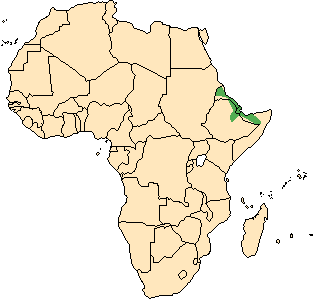![]() Return
to Perissodactyla
Return
to Perissodactyla
Classification
|
 Equus asinus
Equus asinus
African wild ass
![]()
Taxonomy
 |
 |
 |
Click on the pictures above for a larger view of the
photographs
|
||
General Characteristics
Body Length: 200 cm / 6.6 ft.
Shoulder Height: 125-145 cm / 4.2-5.5 ft.
Tail Length: 42 cm / 17 in.
Weight: 275 kg / 605 lb.The short, smooth coat is a light grey to fawn colour, fading quickly to white on the undersides and legs. There is a slender, dark dorsal stripe in all subspecies, while in the Nubian wild ass (E. a. africanus), as well as the domestic donkey, there is a stripe across the shoulder. The legs of the Somali wild ass (E. a. somalicus) are horizontally striped with black, resembling those of a zebra. On the nape of the neck there is a stiff, upright mane, the hairs of which are tipped with black. The ears are large with black margins. The tail terminates with a black brush. The hooves are slender, approximately the diameter of the legs.
Ontogeny and Reproduction
Gestation Period: 11-12 months.
Young per Birth: 1
Weaning: At 6-8 months.
Sexual Maturity: 2 years.
Life span: Up to 40 years.
Ecology and Behavior
The African wild ass is primarily active in the cooler hours between late afternoon and early morning, seeking shade and shelter amongst the rocky hills during the day. Swift and sure-footed in their rough, rocky habitat, the African wild ass has been clocked at 50 kmph / 30 mph. Mature males defend large territories around 23 square kilometers in size, marking them with dung heaps - an essential marker in the flat, monotonous terrain. Due to the size of these ranges, the dominant male cannot exclude other males. Rather, intruders are tolerated - recognized and treated as subordinates, and kept as far away as possible from any of the resident females. In the presence of estrous females the males bray loudly. Despite being primarily adapted for living in an arid climate, African wild asses are dependent on water, and when not receiving the needed moisture from vegetation they must drink at least once every three days. However, they can survive on a surprisingly small amount of liquid, and have been known to drink salty or brackish water.Family group: Small, unstable, mixed herds, with a top number of 49 animals.
Diet: Grasses, bark, and leaves.
Main Predators: Humans.
Distribution
Semideserts, grasslands, and low scrubland in far eastern Africa.

Range Map (Redrawn from IEA, 1998)
Conservation Status
The African wild ass is classified as critically endangered by the IUCN (1996).
Remarks
This species is believed to be the ancestor of the domestic donkey, which is usually placed within the same species. The species name for the African wild ass is sometimes designated as africanus. Equus (Latin) a horse. Asinus (Latin) an ass.
Literature Cited
IEA (Institute of Applied Ecology) 1998. Equus africanus. In African Mammals Databank - A Databank for the Conservation and Management of the African Mammals Vol 1 and 2. Bruxelles: European Commission Directorate. Available online at http://gorilla.bio.uniroma1.it/amd/amd247b.htmlKingdon, J. 1997. The Kingdon field guide to African Mammals. Academic Press, London and New York: Natural World.
Klingel, H. 1990. Horses. In Grzimek's Encyclopedia of Mammals. Edited by S. P. Parker. New York: McGraw-Hill. Volume 4, pp. 557-594.
Nowak, R. M. [editor]. 1991. Walker's Mammals of the World (Fifth Edition). Baltimore: The Johns Hopkins University Press.
Wilson, D. E., and D. M. Reeder [editors]. 1993. Mammal Species of the World (Second Edition). Washington: Smithsonian Institution Press. Available online at http://nmnhwww.si.edu/msw/
Return to Perissodactyla

![]()
© Brent Huffman, www.ultimateungulate.com |
|
|